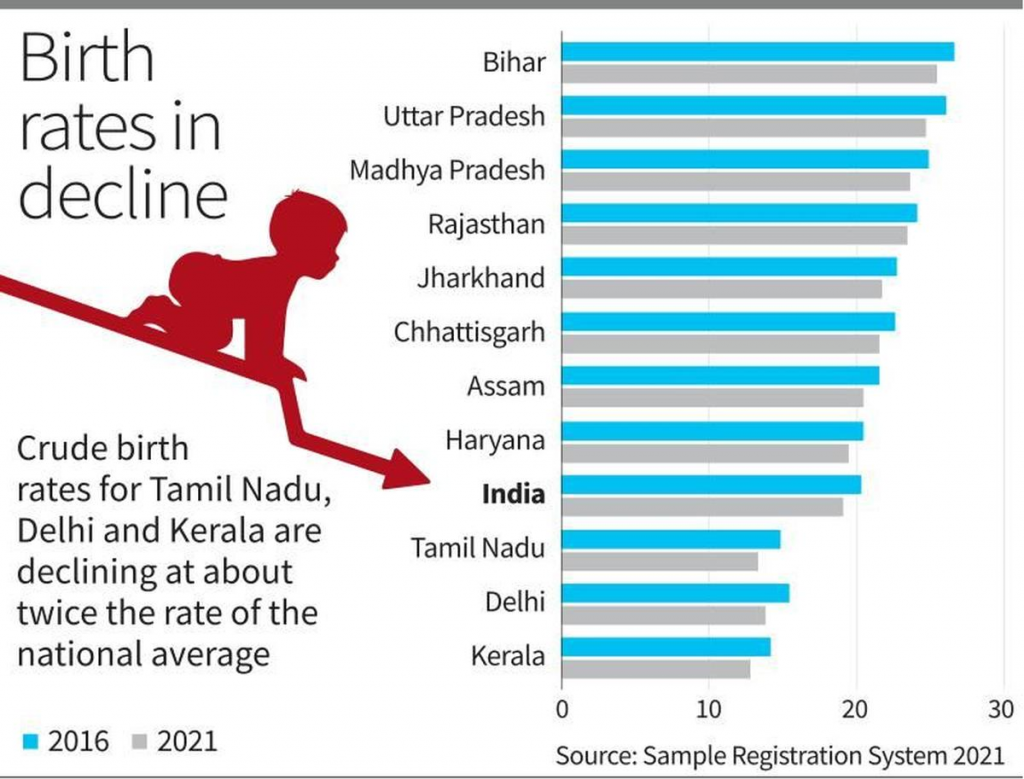Syllabus: GS1/Human Geography
Context
- The annual crude birth rates for Tamil Nadu, Delhi and Kerala are declining at twice the rate of the national average.
About
- The data from the Sample Registration System (SRS) Statistical Report 2021, was released by the Registrar General of India.
- The SRS is the largest demographic survey in the country, meant to provide annual estimates on fertility and mortality indicators such as birth rates, death rates, etc.
- The crude birth rate (CBR) is a demographic measure that indicates the number of live births per 1,000 people in a population during a specific time period, usually a year.
Major Findings
- India’s Total Fertility Rate (TFR) has remained constant at 2.0 in 2021, the same as in 2020.
- The average number of children born to a woman during her childbearing years.
- A TFR of 2.1 is considered the replacement level needed to maintain a stable population.
- All-India crude birth rate was 19.3 in 2021, dropping at a rate of 1.12% every year from 2016 to 2021.
- The birth rate for Tamil Nadu has been declining at a rate of 2.35% every year, Delhi’s has been declining at a rate of 2.23% and Kerala’s is dropping at a rate of 2.05%.
- Birth rates were seen declining faster than the national average for Maharashtra (1.57%), Gujarat (1.24%), Odisha (1.34%), Himachal Pradesh (1.29%), Haryana (1.21%), and Jammu and Kashmir (1.47%).
- The slowest rate of decline in birth rate was seen in States such as Rajasthan (0.48%), Bihar (0.86%), Chhattisgarh (0.98%), Jharkhand (0.98%), Assam (1.05%), Madhya Pradesh (1.05%), West Bengal (1.08%), and Uttar Pradesh (1.09%).
- Rise in the number of registered births were seen in about 11 States and union territories: Bihar, Rajasthan, Uttar Pradesh, Uttarakhand, West Bengal, Jammu and Kashmir, Ladakh, Lakshadweep, Arunachal Pradesh, Mizoram and Nagaland.
- Total fertility rate (TFR): States such as Bihar, Uttar Pradesh, Rajasthan, Madhya Pradesh had a TFR higher than the national average.
- The TFR measures the average number of children expected to be born per woman during her entire span of reproductive period.
- Gross reproduction rate (GRR): The GRR for India stood at 1, meaning that on an average, each woman in India is having one daughter who survives to reproductive age and has children of her own.
- In Bihar, Rajasthan, Madhya Pradesh, and Uttar Pradesh the GRR was significantly higher than the India average.

Concerns
- Uneven Decline in Birth Rates Across States: Some states (e.g., Bihar, UP, MP, Rajasthan) show slow or minimal decline in birth rates, contributing to regional population imbalances.
- These high-birth-rate states may continue to drive overall population growth, putting pressure on resources, infrastructure, and services.
- Demographic Divergence Between Regions: Southern and western States are moving toward or below replacement-level fertility, while northern and eastern States remain above it.
- This creates policy and planning complexity — a “two-speed” demographic transition in the country.
- Aging Population Risk in Low Fertility States: States with low TFR (e.g., Kerala, West Bengal) risk aging population challenges shrinking labor force, increased burden on healthcare and pensions, and need for revised economic and social policies.
- Persistent High Fertility in Some States: Despite national TFR at 2.0, states like Bihar (TFR 3.0) and UP (TFR 2.7) still report high fertility.
- Indicates gaps in education, healthcare, and awareness, particularly in rural and underserved areas.
Way Ahead
- Enhance Family Planning Services: Expand access to contraception and reproductive health, especially in high-fertility states.
- Promote Female Education: Focus on girl child education and awareness to delay marriage and childbirth.
- Improve Data Quality: Align and strengthen SRS and CRS systems; expedite the delayed Census for accurate planning.
- Prepare for Aging Population: In low-fertility states, build systems for elderly care, healthcare, and pensions.
- Address Regional Imbalances: Promote development in high-growth regions through jobs, education, and infrastructure.
- Policy Coordination: Ensure Centre-State collaboration and flexible funding for population control programs.
Source: TH
Previous article
News In Short-14-05-2025
Next article
B.R. Gavai Sworn in as Chief Justice of India